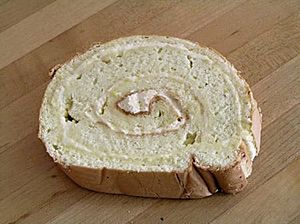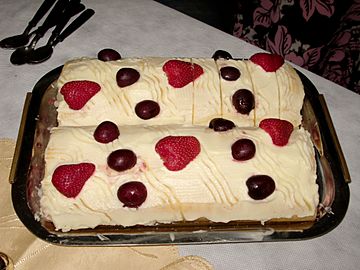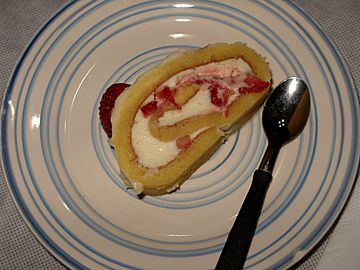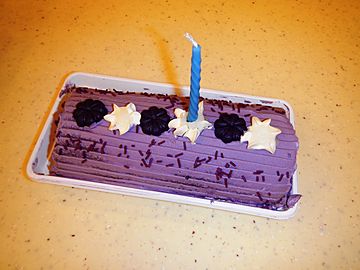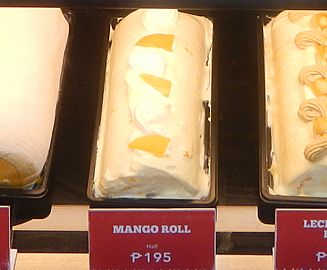Swiss roll facts for kids
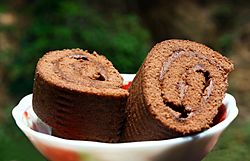
A Sri Lankan Swiss roll
|
|
| Alternative names | Jelly roll, roll cake |
|---|---|
| Type | Sponge cake |
| Place of origin | Central Europe (possibly Austria) |
| Main ingredients | Flour, eggs, sugar, jam or buttercream |
A Swiss roll is a yummy type of cake that is rolled up! It's also known as a jelly roll or roll cake. This cake is made from a thin, light sponge cake that's spread with tasty fillings like whipped cream, jam, or buttercream. Then, it's carefully rolled into a spiral shape.
Even though it's called a "Swiss roll," most people think it actually came from somewhere else in Central Europe, maybe Austria. It became popular in the 1800s, around the same time as other famous cakes like Battenberg cake and Victoria sponge. In the United States, you might know commercial versions by brand names like Ho Hos or Yodels. A special kind of roll cake called a Yule log is often eaten during Christmas.
The cool spiral shape of the Swiss roll has even inspired names in other areas, like the "Swiss roll" metamaterial in science, which is used in optics!
Contents
History of the Swiss Roll

The idea of a rolled cake with jelly inside is quite old! The first time we see a recipe for a rolled cake with jelly was in a journal called Northern Farmer in New York in December 1852. This recipe was called "To Make Jelly Cake." It told people to bake the cake quickly, spread it with jelly while it was hot, roll it carefully, and then wrap it in a cloth. Once it was cold, you could slice it up to eat.
Over the years, the name for this dessert changed a lot in America. It was called "Jelly Cake" in 1852, then "Roll Jelly Cake," "Swiss Roll," "Jelly Roll," and "Rolled Jelly Cake" by 1876. Eventually, "Jelly Roll" became the most common name.
In England, one of the earliest mentions of a "Swiss roll" was in a newspaper in Birmingham in 1856. This suggests that Swiss rolls might have been around in England as early as 1842. By the 1880s and 1890s, many cookbooks in London were using the name "Swiss roll."
An American cookbook from 1894, The American Pastry Cook, even listed different types of rolled cakes made from a basic "Jelly Roll Mixture." These included the Swiss roll, Venice roll, Paris roll, and chocolate roll.
Swiss Rolls Around the World
Germany
In Germany, Swiss rolls are called Bisquitrolle, which simply means "sponge roll." They are also sometimes named after their filling, like Zitronenrolle (lemon roll) or Erdbeerrolle (strawberry roll).
Czech Republic
In the Czech Republic, the Swiss roll is known as roláda or piškotová roláda. You can find them in many pastry shops called cukrárna. They come in lots of different flavors, such as chocolate, cream, coconut, nuts, fruit, and jam.
Hong Kong Style
Hong Kong
This cake likely came to Hong Kong from the UK because Hong Kong was a British territory for a long time. Swiss rolls were sold in bakeries alongside other Chinese pastries even before modern Western-style bakeries appeared. There are a few popular kinds:
- Swiss roll (Chinese: 瑞士卷): This is made with a standard cake recipe and usually has a whipped cream filling.
- Chocolate Swiss roll (Chinese: 朱古力瑞士卷): This version has chocolate flavor in the cake layer and also a whipped cream filling.
- Some bakeries create their own special versions, like cakes with swirled layers of egg and chocolate. Other fillings can include strawberry, coffee, or orange.
Overseas Chinatowns
Many Chinese bakeries in the US sell the basic Hong Kong Swiss roll. It looks and tastes very similar to the ones in Hong Kong. A popular type of Swiss roll in these bakeries is the tiger roll (Chinese: 虎皮蛋糕卷). It has a golden, striped look on the outside, which comes from a special egg yolk layer. Inside, it has traditional white cream.
India
In India, Swiss rolls are often called "jam rolls."
Indonesia
In Indonesia, the Swiss roll cake is called bolu gulung. Most bakeries sell them every day. They are filled with butter cream, cheese, or fruit jam. You can often buy them by the slice, but some shops sell whole rolls too.
Italy
In Sicily, near Caltanissetta, there's a cake called the rollò. It's made with chocolate sponge cake, ricotta cheese, and marzipan.
Japan
In Japan, Swiss rolls are known as "roll cake." They are usually filled with whipped cream and sometimes with fresh fruits like strawberries.
Latin America
In Colombia, a Swiss roll is called either pionono or brazo de reina ("queen's arm"). It's often filled with dulce de guayaba (guava jam) or arequipe (a sweet caramel sauce). In Argentina, Uruguay, and Peru, it's also called pionono and is filled with dulce de leche. In Chile, it's called brazo de reina, filled only with dulce de leche, and sprinkled with powdered sugar.
In Puerto Rico and Venezuela, it's known as brazo de gitano. It can have many different fillings, including cream, chocolate, guava jam, or dulce de leche, often mixed with fruits. In Brazil, it's called rocambole. In Mexico, it's known as nino envuelto ("wrapped child"). In Ecuador and Guatemala, it's called a brazo gitano ("gypsy's arm").
Southeast Asia
In Southeast Asia, you can find many different kinds of Swiss rolls. Popular flavors include kaya (coconut jam), pandan, blueberry, strawberry, sweet potato, taro, vanilla, orange, chocolate, and raspberry. You can even find them with local fruits like durian, cempedak, and mango.
Philippines
In the Philippines, a similar traditional pastry is the pionono. It has been a common treat in local bakeries since the Spanish colonial period. It's a rolled version of the traditional Filipino sponge cakes (mamón) and originally had a simple filling of sugar and butter. Today, modern versions often have frosting and many different fillings.
A very popular type is the pianono version of the ube cake, often called "ube rolls." It's flavored with ube (purple yam) and macapuno (a type of coconut), which gives it a bright purple color. Mango pianono or "mango roll" is also popular. It's made with ripe Carabao mangoes and cream. Another special traditional pianono is the brazo de Mercedes ("arm of Our Lady of Mercy"), which has a soft meringue (whipped egg white) outside and a creamy custard filling. Because of American influence, pianonos are now often called "cake rolls."
-
Filipino mango rolls
-
Filipino ', a meringue roll
Portugal
In Portugal, desserts called tortas are often found on restaurant menus. These are not like the tarts you might know; they are simply Swiss rolls with jam filling.
Nordic Countries
In Denmark, Norway, and Sweden, the Swiss roll is called roulade, rullade, or rulltårta. In some parts of Norway, it's also called rullekake or swissrull.
In Sweden and Finland, the Swiss roll is called rulltårta (or kääretorttu in Finnish), both meaning "roll-cake." It's often served with coffee. The filling usually has butter cream and strawberry jam. There's a chocolate version called drömrulltårta ("dream roll-cake"), which is made mostly with potato flour instead of regular wheat flour, and it's filled with butter cream. Bakeries also make fancier versions, like ones with whipped cream and banana inside, or with a thin marzipan coating that looks like a birch log.
Spain
In Spain, this dessert is called brazo de gitano (which means "gypsy's arm"). It's commonly filled with cream, jam (like peach or apricot), powdered cocoa, and nuts.
Switzerland
Even though it's called a "Swiss roll," this cake doesn't seem to have started in Switzerland. In Switzerland, they call it Biskuitroulade or Roulade in German, gâteau roulé or roulade in French, rotolo or biscotto arrotolato in Italian, and rullada in Rumantsch.
United Kingdom
In the United Kingdom, Swiss rolls are popular for teatime or as a dessert. Supermarkets sell many kinds, such as chocolate, lemon, or jam (which is the most popular). Jam Swiss rolls are filled with jam and sometimes cream, and might have sugar or chocolate drizzled on top. A similar dessert is Jam roly-poly, but that's a hot pudding made with suet, filled with jam, and served with custard.
"Caterpillar cakes" are Swiss rolls decorated to look like caterpillars. A very famous one is Marks and Spencer's Colin the Caterpillar.
United States

In the United States, professional pastry chefs often use the French term roulade. The chocolate Swiss roll, sometimes called a "chocolate log," is a very popular cake or dessert. Many companies make them, and common brands include Ho Hos and Yodels, which are smaller rolls for one person. When the filling is ice cream, it's usually called an "ice cream cake roll." These often have chocolate cake with vanilla ice cream.
In Puerto Rico, people eat the Spanish version called brazo de gitano with guava and cream cheese.
See also
 In Spanish: Brazo de gitano para niños
In Spanish: Brazo de gitano para niños


